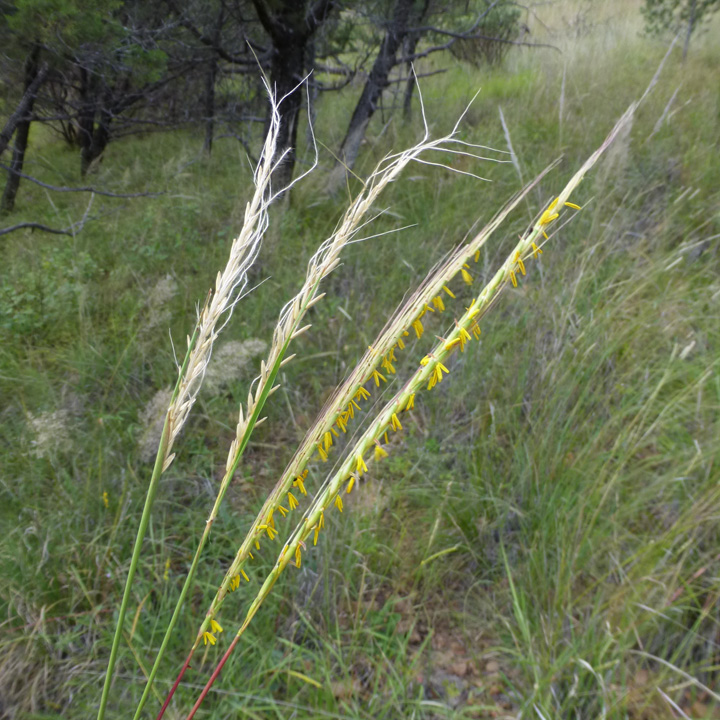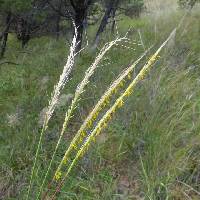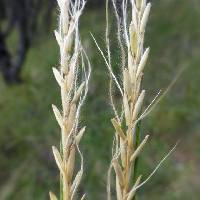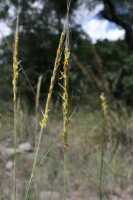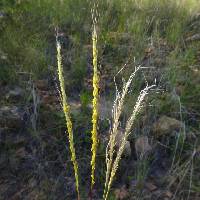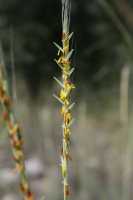Common Name: spiked crinkleawn
Duration: Perennial
Nativity: Native
Lifeform: Graminoid
General: Tufted perennial grass, stems 60-120 cm, unbranched, hispid at nodes.
Vegetative: Leaves glabrous or occasionally hirsute with soft, spreading hairs; ligules large and firm, 2-5 mm long, acute; blades 2-6 mm broad, flat or involute.
Inflorescence: Terminal, solitary racemes, 10-18 cm long and 1 cm or less thick, with subsessile-pedicillate spikelet pairs. Subsessile spikelets staminate or sterile, without a callus and unawned, otherwise similar to the pedicellate spikelets. Pedicellate spikelets bisexual, 6-8 mm; calluses sharp, strigose; glumes firm, pilose, enclosing the florets; lower florets sterile; upper florets bisexual, the lemmas firm but hyaline at the base, tapering to a long awn; awns 4-6 cm, twisted, pilose below with 1-2 mm hairs, glabrous above. Disarticulation below the pedicellate spikelets.
Ecology: Dry, rocky slopes; 1,000-6,000 ft (305-1829 m); flowers August to October.
Distribution: AZ, sw NM, s TX; south to s MEX, S. America; Africa.
Notes: Distinguished by being a perennial bunchgrass with terminal racemes of spikelets with pale, bent, long-hairy awns and pale glumes also with long hairs. Resembes Heteropogon, but the awns do not twist together, are pale and shorter, and the racemes do not break apart between the spikelets at maturity. Makes good fodder although it is seldom found in dense stands except occasionally on steep slopes and in canyon bottoms. This species is the only native Trachypogon to our region, and has gone by quite a few names over the years. FNA treats it as Trachypogon secundus, but other taxonomists group it into T. spicatus.
Ethnobotany: Archaeological evidence shows this species was used extensively for thatch material in El Salvador, in an area where the species does not currently grow.
Etymology: Trachypogon comes from Greek trachys, rough and and pogon, bearded, while spicatus means flowers in a spike.
Synonyms: Andropogon montufari, Heteropogon secundus, Stipa spicata, Trachypogon montufari, Trachypogon secundus
Editor: SBuckley 2010, FSCoburn 2014, AHazelton 2015
Plants perennial. Culms 60-120 cm, erect; nodes appressed-hirsute. Sheaths sparsely appressed-pilose; ligules 2-5 mm, stiff, acute; blades usually 12-35 cm long, 3-8 mm wide, with a broad midrib. Racemes 10-18 cm, the internodes glabrous. Pedicellate spikelets 6-8 mm; glumes pilose; awns 4-6 cm, pilose below, with 1-2 mm hairs, nearly glabrous distally; anthers 4-5 mm, orange. 2n = 20.
Trachypogon secundus is found in sandy prairies, woodlands, rocky hills, and canyons, in well-drained soils at 500-2000 m. Statements about is range are difficult to make because of disagreement as to whether northern plants, such as those found in the Flora region, belong to the same species as those found elsewhere.
Trachypogon secundus resembles Heteropogon, differing in its longer, non-disarticulating inflorescence and shorter, pale awns. It rates as fairly good fodder when green, but is seldom abundant enough to be an important forage grass.


